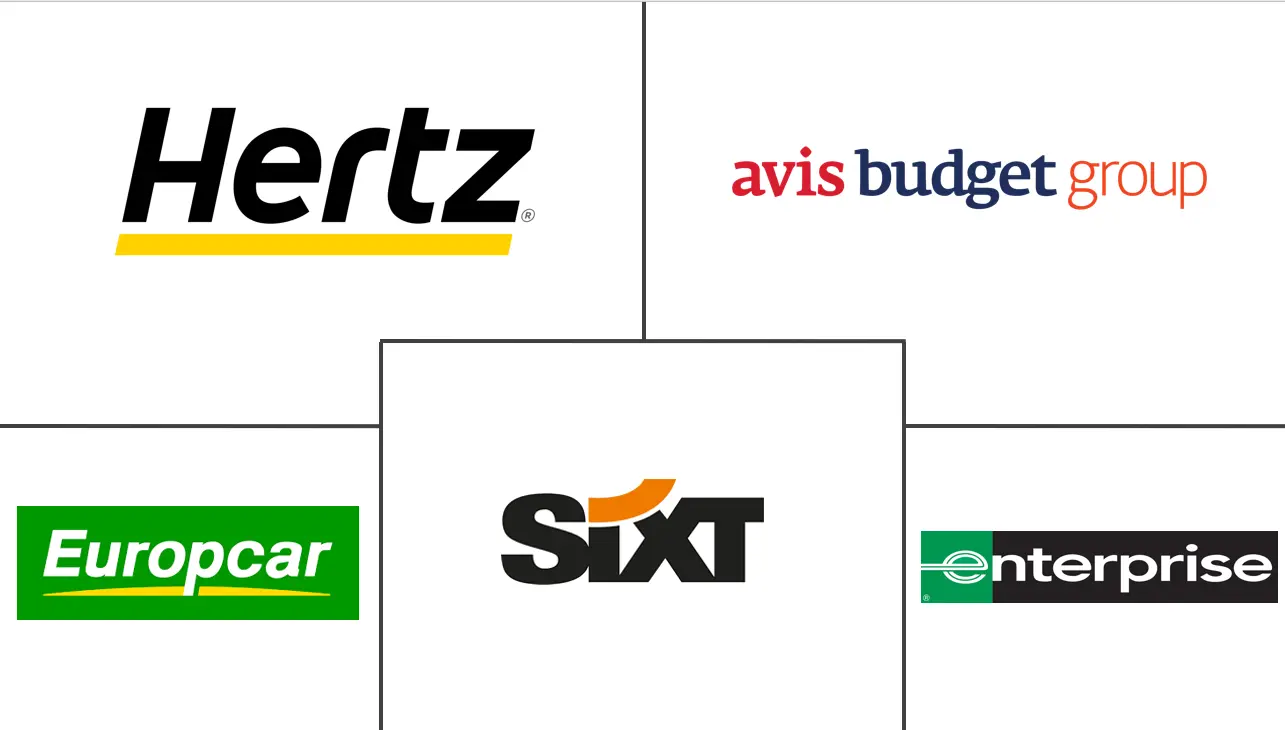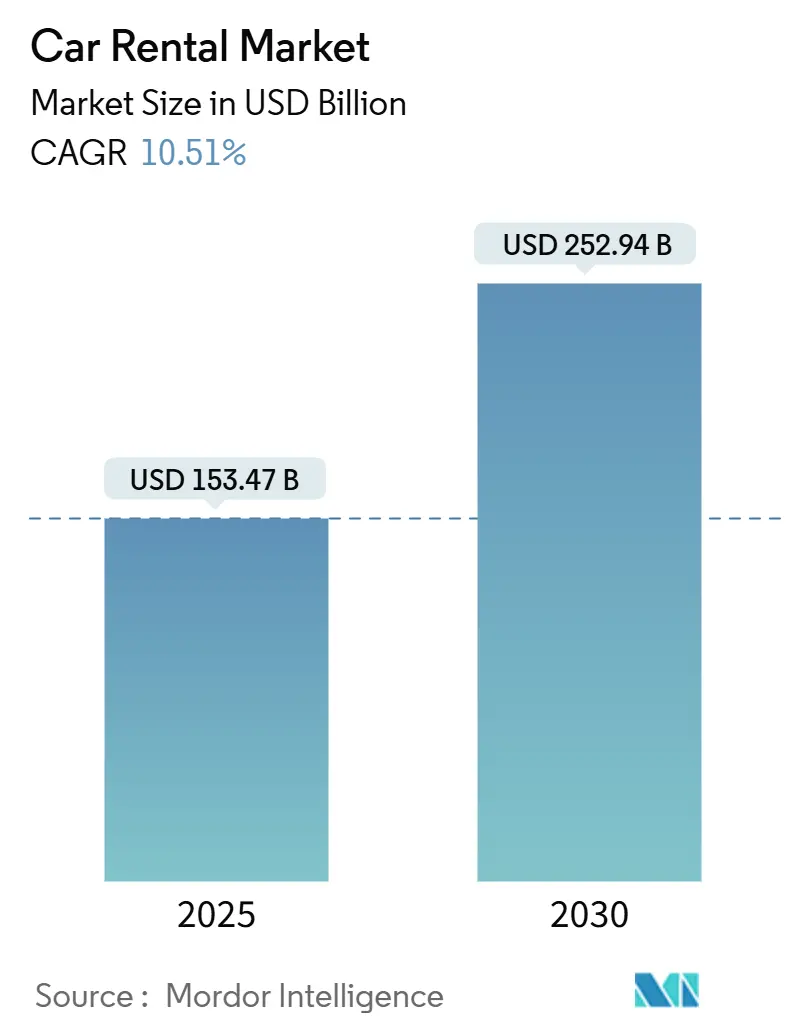
Car Rental Market Analysis by Mordor Intelligence
The Car Rental Market size is estimated at USD 153.47 billion in 2025, and is expected to reach USD 252.94 billion by 2030, at a CAGR of 10.51% during the forecast period (2025-2030). This trajectory confirms the sector’s decisive rebound from its pandemic trough. Rising disposable income in emerging economies, continued airport infrastructure upgrades, and wider access to digital booking channels are steering sustained demand. Operators are capturing incremental revenue by matching dynamic pricing engines with data on flight arrivals, highway congestion, and local events. Peer-to-peer platforms, once considered fringe, have doubled down on safety guarantees and loyalty perks, drawing new hosts into the ecosystem. Fleet electrification remains uneven, yet corporate sustainability mandates have ensured steady procurement of low-emission models despite headline-grabbing write-downs at some incumbents.
Key Report Takeaways
- By booking mode, offline platforms led the car rental market with a 54.8% share in 2024, while online platforms are forecast to grow at a 10.57% CAGR during the forecast period (2025-2030).
- By application, leisure travel had a 56.21% share in the car rental market in 2024 and is expected to advance at a 10.61% CAGR during the forecast period (2025-2030).
- By end user, self-drive individuals held 66.74% of the car rental market share in 2024, while peer-to-peer hosts recorded the highest projected CAGR at 10.67% during the forecast period (2025-2030).
- By vehicle type, mini and economy cars captured a 36.82% share in the car rental market in 2024. SUVs and MPVs are set to expand at a 10.55% CAGR during the forecast period (2025-2030).
- By rental length, short-term bookings represented a 65.53% share in the car rental market in 2024, whereas long-term subscriptions are poised to grow at a 10.68% CAGR during the forecast period (2025-2030).
- By geography, North America retained a 35.41% share in the car rental market in 2024, and Asia-Pacific is projected to grow fastest at a 10.71% CAGR during the forecast period (2025-2030).
Global Car Rental Market Trends and Insights
Drivers Impact Analysis
| Driver | (~) % Impact on CAGR Forecast | Geographic Relevance | Impact Timeline |
|---|---|---|---|
| Rapid Rebound Of Post-Pandemic Leisure Travel | +2.8% | Global, with stronger impact in North America and Europe | Short term (≤ 2 years) |
| Growing Penetration Of Online Booking Platforms | +2.1% | Global, with accelerated adoption in Asia-Pacific | Medium term (2-4 years) |
| Expansion Of Low-Cost Airlines | +1.9% | Asia Pacific core, spill-over to Middle East and Africa and Latin America | Medium term (2-4 years) |
| Corporate ESG Mandates Accelerating Adoption Of EV Rental Fleets | +1.7% | North America and EU, early adoption in urban centers | Long term (≥ 4 years) |
| Data-Driven Dynamic Pricing Tools | +1.4% | Global, with advanced implementation in developed markets | Medium term (2-4 years) |
| Airport Infrastructure Upgrades | +1.2% | Asia-Pacific, Middle East, selective African markets | Long term (≥ 4 years) |
| Source: Mordor Intelligence | |||
Rapid Rebound Of Post-Pandemic Leisure Travel
Leisure passenger volumes have eclipsed pre-covid peaks, with U.S. Transportation Security Administration screenings up less than one-tenth year over year and mirrored surges seen at European airports[1]“Checkpoint Travel Numbers for 2025,” Transportation Security Administration, tsa.gov . Higher seat factors translate directly into stronger rental counter throughput, particularly on weekends when hybrid work allows extended stays. Travelers are booking earlier and keeping cars longer, a pattern that lifts revenue per transaction for operators employing day-based utilization targets. Bleisure trips lengthen average rental duration as executives tack on personal days. Normalizing corporate meetings add weekday demand density, allowing fleet planners to deploy assets more evenly through the week. Price resilience remains evident, with American Express Global Business Travel forecasting U.S. daily rates to inch up slightly across 2025 despite rising fleet capacity[2]“Air Monitor 2025,” American Express Global Business Travel, gbt.americanexpress.com .
Growing Penetration Of Online And Mobile Booking Platforms
As digital channels redefine customer acquisition, Avis Budget Group's cloud-native pricing system swiftly tailors offers for its loyalty members[3]“Rate Shop Modernization Press Release,” Avis Budget Group, avis.com . Mobile apps streamline check-in, upsell insurance, and permit mid-trip extensions with one tap, shrinking counter dwell time. Seamless payment flows encourage cross-selling roadside assistance, toll packages, and lifting attachment rates. Uber riders in select cities can now reserve Turo vehicles directly through the Uber app, seamlessly integrating the two platforms. This move channels millions of monthly active users into Turo's rental funnel, all at a marginal cost[4]“Uber and Turo Partnership Announcement,” Uber Technologies Inc., uber.com . Predictive analytics harvests clickstream and flight data to refine city-pair demand curves, allowing operators to rebalance inventory before peak surges hit.
Expansion Of Low-Cost Airlines Creating Multi-Modal Travel Demand
Low-cost carriers are opening secondary airports that sit far outside city limits, catalyzing last-mile rental demand. Adani’s redevelopment of Mumbai International is designed for massive incremental passengers by 2025, with adjacent pick-up bays earmarked for rental fleets. Point-to-point flight networks encourage travelers to design open-jaw itineraries that require flexible surface mobility. In Southeast Asia, domestic tourists bundle low-fare flights with self-drive vacations because intercity rail remains patchy. Operators that partner directly with airlines capture bundled booking traffic and secure prime curb space at new terminals. These linkages forge an integrated mobility narrative that positions a rental vehicle as the logical extension of an air ticket.
Corporate ESG Mandates Accelerating Adoption Of EV Rental Fleets
Global enterprises have set science-based targets that cascade down to travel policies, nudging employees toward low-emission options. Enterprise Mobility now fields thousands of battery electric vehicles across the United States, Canada, and Europe to meet these mandates. UK corporations are increasingly adopting electric vehicles, as evidenced by the country's leased fleet, which boasts markedly lower average CO₂ emissions and a substantial portion of deliveries being battery electric. Premium pricing on EV classes helps defray acquisition costs, yet high depreciation and repair bills strain margins. Hertz is strategically offloading a large segment of its electric vehicle fleet, incurring associated financial charges, all in a bid to manage its risks better. Operators continue to pilot subscription bundles that wrap carbon reporting and charging access into a single fee, aligning with procurement teams’ sustainability dashboards.
Restraints Impact Analysis
| Restraint | (~) % Impact on CAGR Forecast | Geographic Relevance | Impact Timeline |
|---|---|---|---|
| Popularity Of Ride-Hailing And Car-Sharing Substitutes | -1.8% | Global, with concentrated impact in urban centers | Medium term (2-4 years) |
| Rising Residual-Value Risk Amid Rapid EV Technology Cycles | -1.5% | Global, with acute impact in markets with high EV adoption | Long term (≥ 4 years) |
| Airport Concession Fees Squeezing Operator Margins | -0.9% | Global, with higher impact in major airport hubs | Medium term (2-4 years) |
| Regulatory Caps On Ice Vehicles | -0.7% | Europe and North America, expanding to Asia-Pacific urban centers | Long term (≥ 4 years) |
| Source: Mordor Intelligence | |||
Popularity Of Ride-Hailing And Car-Sharing Substitutes
App-based rides are taking the lead in ground transport spending, with platforms like Uber and Lyft dominating urban travel, marking a decline for traditional rentals. Fare transparency, cashless payment, and driver-as-concierge appeal to city visitors reluctant to navigate traffic and parking. Peer-to-peer platforms layer another competitive vector: These models dodge airport concession fees, allowing lower headline prices. Traditional operators have responded with fast-pass pick-up lanes and entering white-label partnerships to regain relevance in downtown corridors. Nonetheless, urban day rentals continue to face structural pressure from on-demand alternatives.
Rising Residual-Value Risk Amid Rapid EV Technology Cycles
Manufacturers' aggressive pricing and rapid battery innovations are shaking up resale expectations. As a result, lessors have adjusted residual values in response to a significant drop in used EV listings, especially those of Teslas. ALG has trimmed residual projections across most EV nameplates, complicating fleet sourcing decisions. Operators contemplating large EV orders must now model multiple disposal scenarios and hedge resale via guaranteed buy-back clauses. The volatility tempers near-term electrification rollouts even as corporate customers clamor for green fleets, creating a push-pull dynamic weighing the car rental market growth curve.
Segment Analysis
By Booking Mode: Digital channels reshape customer acquisition
In 2024, offline platforms commanded a 54.8% share of the car rental market. Meanwhile, online platforms are projected to experience a robust growth rate of 10.57% CAGR during the forecast period (2025-2030). This evolving landscape has diminished the prominence of traditional brick-and-mortar counters, yet paradoxically broadened the global reach of even mid-tier brands. The convenience is palpable for loyalty members: pre-populated profiles and secure mobile keys allow them to bypass counters entirely, streamlining their experience. Moreover, with push notifications alerting them to flight delays, customers can effortlessly adjust pick-up times, enhancing overall satisfaction. While offline walk-ups still play a role in areas with limited smartphone access, they grapple with higher booking costs due to staffing and facility expenses.
Digital traffic is increasingly converging with airline applications, hotel platforms, and third-party online travel agencies, now cross-selling mobility options. This integration reduces customer acquisition costs and paves the way for additional revenue through bundled services like insurance and GPS add-ons. Furthermore, the data reservoirs generated from these transactions provide fleet planners with foresight into city-pair demands, enabling timely fleet transfers and reducing idle days. As a result, operators adopting API-first strategies have significantly outpaced their competitors in utilization metrics within the car rental sector.
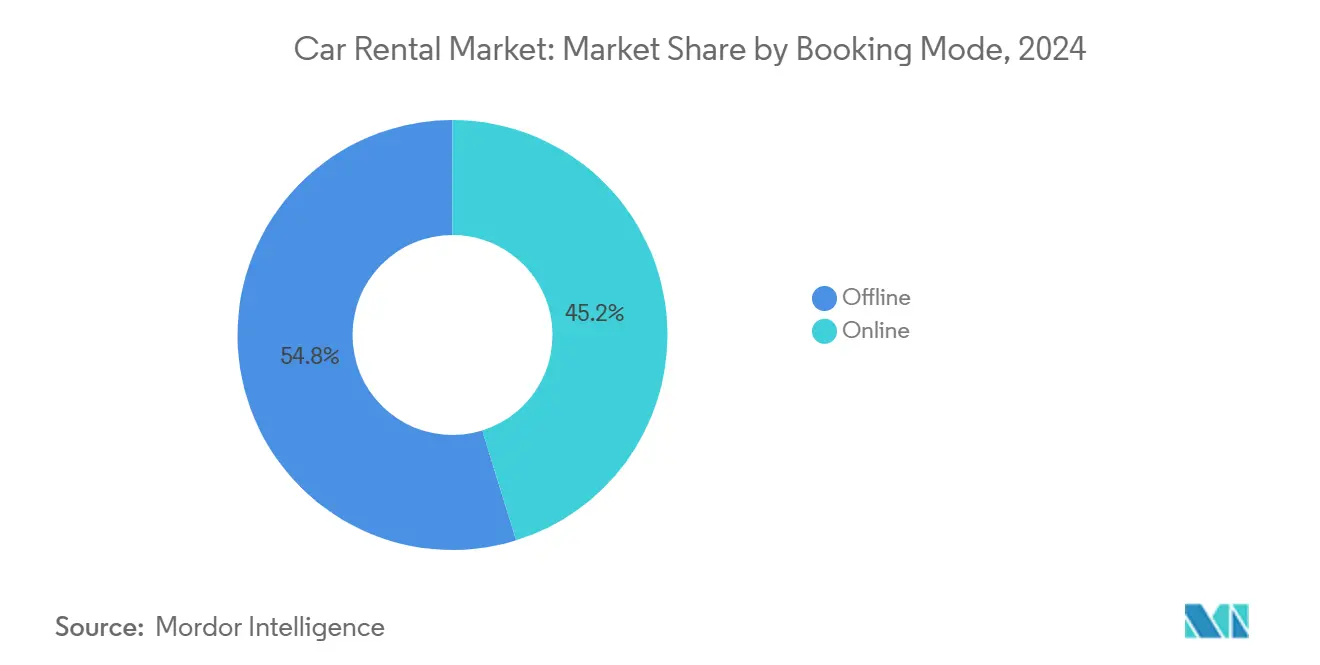
By Application: Leisure travel drives market expansion
Based on experiential tourism trends, leisure travelers generated a 56.21% share of the car rental market in 2024 and will sustain a 10.61% CAGR during the forecast period (2025-2030). Families designing multi-stop road vacations prize vehicle control and luggage flexibility unavailable on group tours. Contactless delivery options introduced during the pandemic remain popular as they let renters proceed directly from baggage claim to parking bay, avoiding crowded shuttle buses. Higher fuel efficiency and spacious cargo areas rank at the top of leisure renters’ preference lists, directing procurement toward crossover models.
Business travel is regaining 2019 trip counts, as the average length of rental has increased due to hybrid work policies that allow employees to add personal days. This blend of business and leisure supports weekday and weekend utilization, smoothing the revenue curve. Programmable corporate accounts that bundle emissions reporting help operators attract sustainability-minded firms, reinforcing demand resilience even if corporate trip volumes plateau.
By End User: Peer-to-peer models disrupt traditional segments
Self-drive individuals retained a 66.74% share of the car rental market in 2024, underlining personal autonomy as the dominant motivator for car rental market customers. Meanwhile, peer-to-peer rentals are growing at a 10.67% CAGR during the forecast period (2025-2030), chipping away at entry-level price tiers. Hosts monetize underused personal vehicles in residential neighborhoods closer to renters than airport depots. Ratings systems and insurance guarantees have eased safety concerns that once limited adoption. Traditional firms respond by repackaging idle cars into urban subscription schemes for local residents, protecting utilization on aging units.
Corporate fleets increasingly explore flexible subscriptions, swapping rigid leasing contracts for rental-based models that adjust as headcounts shift. This pivot channels some enterprise kilometers toward long-term rental agreements, including maintenance and roadside service. Chauffeur-drive services cater to executives and luxury tourists in jurisdictions with challenging road conditions, yet comprise a small slice of the overall car rental market.
By Vehicle Type: SUVs lead growth despite economy dominance
Mini and economy cars control a 36.82% share of the car rental market in 2024 due to price-sensitive travelers and corporations that enforce daily rate caps. Still, SUVs and MPVs are projected to record the fastest 10.55% CAGR during the forecast period (2025-2030), capturing aspirational demand and accommodating group travel. Higher seating positions and perceived safety boost their popularity among families. Fleet managers must weigh more substantial daily revenues against steeper acquisition and fuel costs, especially in regions lacking tax incentives for efficient powertrains.
Luxury and premium segments yield robust per-day margins but remain vulnerable to ride-hailing substitutes offering chauffeured premium vehicles. Operators pursue manufacturer buy-backs or guaranteed residual value contracts to de-risk prestige fleets. Meanwhile, commitments like SIXT’s order for up to 250,000 Stellantis units signal a broad-based pivot toward electrified powertrains, covering everything from compact hatchbacks to midsize SUVs.
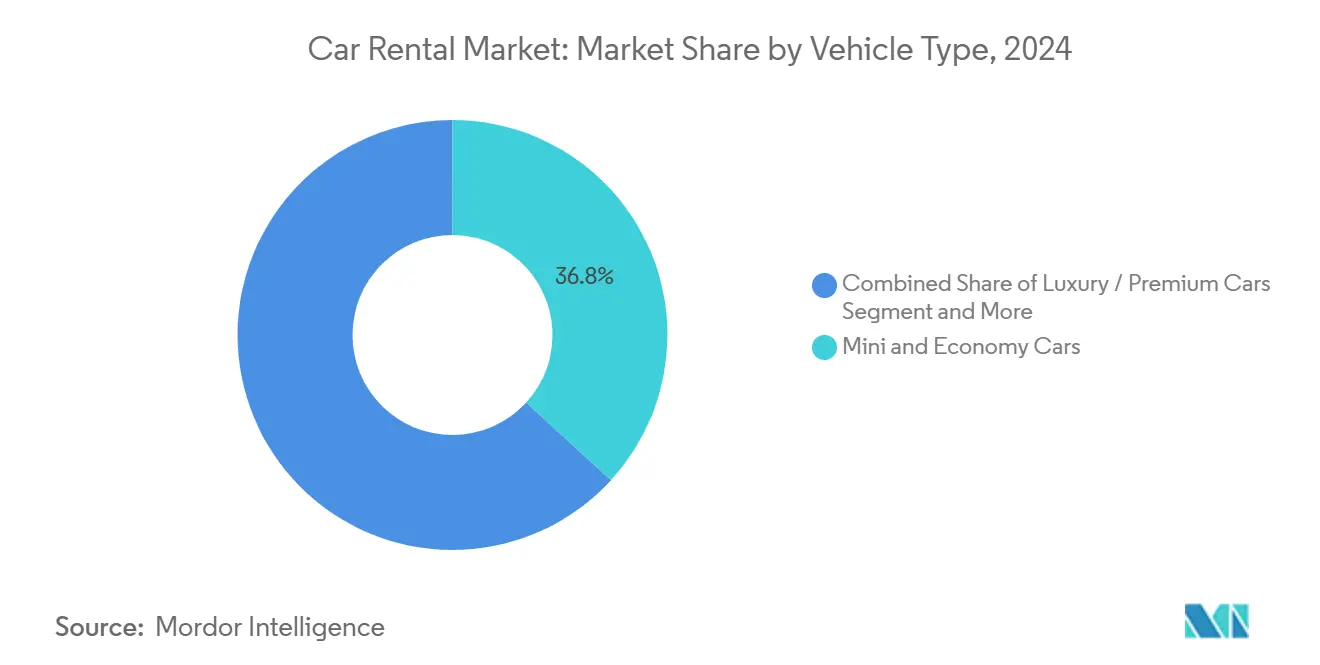
Note: Segment shares of all individual segments available upon report purchase
By Rental Length: Long-term subscriptions transform business models
Short-term rentals held a 65.53% share of the car rental market in 2024, yet long-term agreements will progress at a 10.68% CAGR during the forecast period (2025-2030). Corporate buyers appreciate the off-balance-sheet nature of month-to-month rentals, while individual consumers in congested metros view subscriptions as a parking-free alternative to ownership. Operators bundle maintenance, insurance, and seasonal swaps under a monthly fee, stabilizing revenue and enhancing fleet predictability. Medium-term rentals serve relocating employees or film crews needing cars for several weeks, filling gaps between daily retail demand and annual lease commitments.
Enterprise Mobility credited slight growth in fleet management services for record FY24 revenue of USD 38 billion, underscoring the profitability of extended-duration contracts. Regulatory bodies are drafting guidelines that blur the line between rental and lease; compliance costs are expected to be modest relative to the upside of predictable cash flows.
Geography Analysis
North America comprises a 35.41% share in the car rental market in 2024, reflecting mature travel infrastructure and a high vehicle ownership culture. Avis Budget Group posted USD 12 billion in 2023 sales as airport passenger flows regained momentum and loyalty program re-enrollments climbed. Dynamic pricing engines exploited flight disruption data to capitalize on last-minute bookings. Electric vehicle uptake remains tempered by charging deserts along rural interstates, yet corporate clients have begun mandating low-emission classes for city centers such as New York and Los Angeles. Competitive intensity is elevated in urban corridors where ride-hailing platforms maintain a stronghold, though rentals still dominate one-way interstate journeys.
Asia-Pacific is forecast to grow with a 10.71% CAGR during the forecast period (2025-2030). Rising middle-class travel, visa-on-arrival schemes, and vigorous airline seat growth underpin market momentum. Enterprise Mobility opened ten Thai branches in 2024 and now operates ninety-seven Japanese sites, illustrating aggressive network build-out. Indonesia, Vietnam, and India report double-digit inbound tourism growth, straining public transit capacity and directing visitors toward self-drive solutions. Chinese EV makers enter the tourist segment by offering discounted electric crossovers via rental partnerships, creating a low-cost path to overseas brand exposure.
Europe remains a sophisticated yet fiercely competitive arena. SIXT’s multi-year deal for 250000 Stellantis vehicles secures supply amid chip shortages and advances its electrification roadmap. Amsterdam introduces zero-emission zones in 2025, prompting operators to reserve high-value parking slots for electric fleets. Cross-border rentals flourish on the continent’s open internal borders, though differing road toll regimes complicate fleet tracking. Europcar’s re-entry into the United States with Atlanta and Dallas outlets signals renewed transatlantic ambitions. Elsewhere, Latin America and the Middle East benefit from improving highway networks and inbound events such as Saudi Arabia’s Vision 2030 tourism push, yet currency volatility and import restrictions require agile capital allocation.
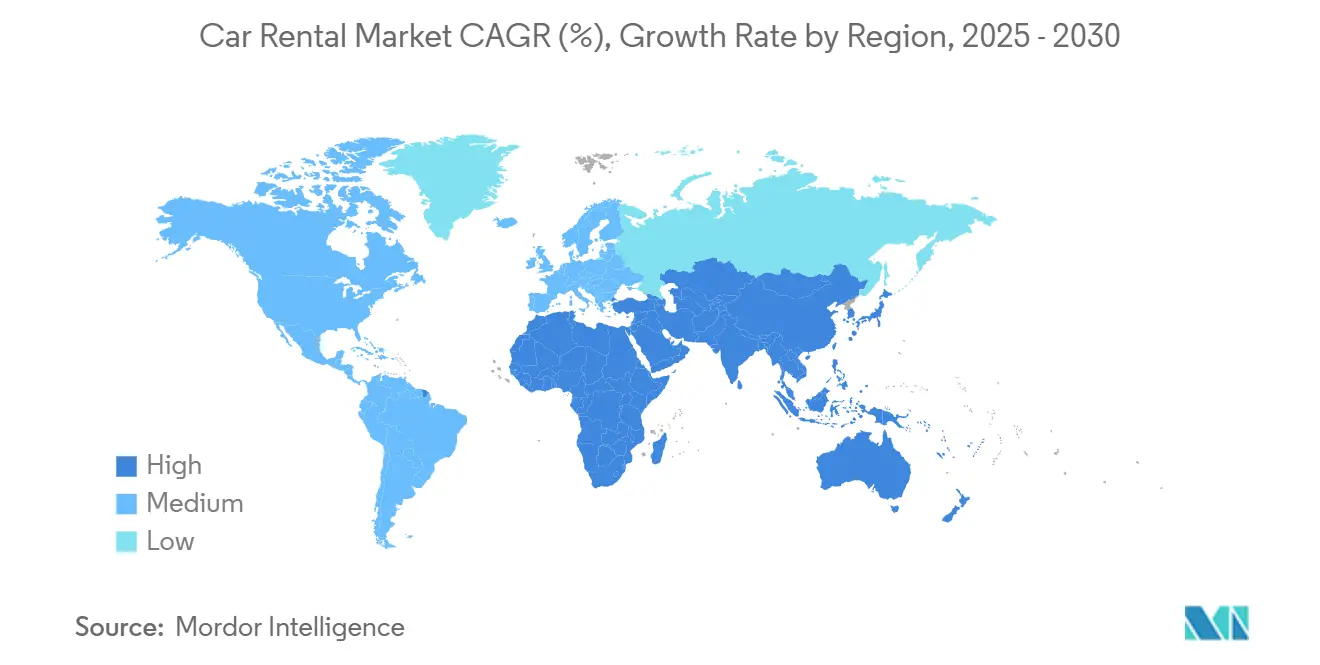
Competitive Landscape
Three incumbents, Enterprise Holdings, Avis Budget Group, and Hertz, anchor a market that admits nimble disruptors. While a handful of major players command a significant share of global revenue, the market still offers ample opportunities for regional leaders to flourish. Enterprise leverages its neighborhood branch density to feed corporate account growth and channels off-lease vehicles into retail remarketing at favorable margins. Avis Budget emphasizes digital transformation, migrating core rate-shopping processes to the cloud for faster experimentation. Hertz continues to right-size its fleet mix after heavy EV write-downs, reallocating capital toward more liquid combustion models.
Peer-to-peer leaders Turo and Getaround capitalize on low fixed costs and rapid host onboarding. Their platforms deploy machine-learning risk engines that approve most trips in seconds, capturing time-sensitive customers. Traditional operators have opted for collaboration rather than confrontation: several now place idle units on peer-to-peer marketplaces during shoulder seasons. Dynamic pricing sophistication has become a competitive wedge. AI-driven yield tools segment customers by churn propensity, preserving margin on inelastic segments while flexing into competitive price bands for leisure shoppers. Fleet electrification strategies diverge: SIXT installs universal chargers at European depots, whereas U.S. independents focus on hybrid models to hedge residual risk.
Turo’s alliance with Uber integrates rental inventory into on-demand mobility flows. Enterprise’s franchise expansion across Thailand secures first-mover advantage in secondary tourism provinces. Each initiative underscores the sector’s pivot from pure asset leasing toward platform-based mobility orchestration.
Car Rental Industry Leaders
-
Avis Budget Group Inc.
-
Sixt
-
Hertz Corp.
-
Enterprise Holdings Inc.
-
Europcar Group
- *Disclaimer: Major Players sorted in no particular order
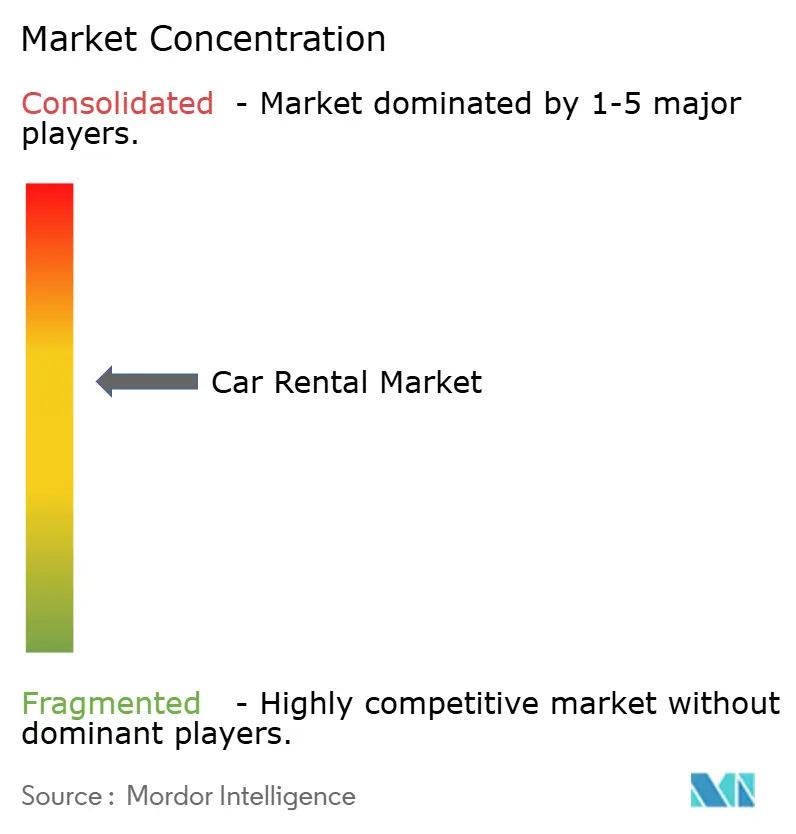
Recent Industry Developments
- October 2024: Enterprise Mobility is making waves in the Asia-Pacific region, marking its latest milestone with a grand opening in Thailand. Through its franchise partner, Thai Rent a Car, the company has ushered in the debut of Enterprise Rent-A-Car, National Car Rental, and Alamo branches. This Thai venture is just one highlight of a broader strategy, with fresh branches sprouting in Japan, South Korea, and New Zealand.
- September 2024: Turo and Uber unveiled a multi-year partnership that will bring peer-to-peer rentals to the Uber app in early 2025 in the United States, the United Kingdom, Canada, Australia, and France.
Global Car Rental Market Report Scope
A car rental, hire car, or car hire agency is a company that rents automobiles for short periods of time to the public, generally ranging from a few hours to a few weeks. The car rental industry statistics report covers the latest market trends and technological developments.
The car rental industry report is segmented by booking type, application type, vehicle type, end-user, rental length, and geography. By booking type, the market is segmented into offline access and online access. By application type, the target market is segmented into leisure/tourism and business. By vehicle type, the market is segmented into luxury/premium cars and economy/budget cars. By end-user, the market is segmented into self-driven and chauffeur-driven. By rental length, the market is segmented into short-term and long-term. By geography, the market is segmented into North America, Europe, Asia-Pacific, South America, and Africa.
For each market segmentation, the industry size, market share, and forecasts have been calculated based on value (USD).
| Offline |
| Online |
| Leisure |
| Business |
| Self-Drive Individual |
| Chauffeur-Drive |
| Corporate Fleet Subscription |
| Peer-to-Peer Rental |
| Mini & Economy Cars |
| Compact & Intermediate Cars |
| Standard & Full-Size Cars |
| SUVs & MPVs |
| Luxury / Premium Cars |
| Short-Term |
| Medium-Term |
| Long-Term |
| North America | United States |
| Canada | |
| Rest of North America | |
| South America | Brazil |
| Argentina | |
| Rest of South America | |
| Europe | Germany |
| United Kingdom | |
| France | |
| Spain | |
| Italy | |
| Russia | |
| Rest of Europe | |
| Asia-Pacific | China |
| India | |
| Japan | |
| South Korea | |
| Rest of Asia-Pacific | |
| Middle East and Africa | United Arab Emirates |
| Saudi Arabia | |
| Turkey | |
| Egypt | |
| South Africa | |
| Rest of Middle East and Africa |
| By Booking Mode | Offline | |
| Online | ||
| By Application | Leisure | |
| Business | ||
| By End User | Self-Drive Individual | |
| Chauffeur-Drive | ||
| Corporate Fleet Subscription | ||
| Peer-to-Peer Rental | ||
| By Vehicle Type | Mini & Economy Cars | |
| Compact & Intermediate Cars | ||
| Standard & Full-Size Cars | ||
| SUVs & MPVs | ||
| Luxury / Premium Cars | ||
| By Rental Length | Short-Term | |
| Medium-Term | ||
| Long-Term | ||
| By Geography | North America | United States |
| Canada | ||
| Rest of North America | ||
| South America | Brazil | |
| Argentina | ||
| Rest of South America | ||
| Europe | Germany | |
| United Kingdom | ||
| France | ||
| Spain | ||
| Italy | ||
| Russia | ||
| Rest of Europe | ||
| Asia-Pacific | China | |
| India | ||
| Japan | ||
| South Korea | ||
| Rest of Asia-Pacific | ||
| Middle East and Africa | United Arab Emirates | |
| Saudi Arabia | ||
| Turkey | ||
| Egypt | ||
| South Africa | ||
| Rest of Middle East and Africa | ||
Key Questions Answered in the Report
How large is the car rental market in 2025?
The car rental market size stands at USD 153.47 billion in 2025.
What is the projected CAGR for car rentals through 2030?
The sector is forecast to register a 10.51% CAGR between 2025 and 2030.
Which region is expected to grow fastest for car rentals by 2030?
Asia-Pacific leads growth with a projected 10.71% CAGR due to rising tourism and infrastructure investment.
Which booking channel holds the largest share of rental reservations?
Online and mobile platforms command 45.18% share and continue to widen their lead.
Why are long-term rental subscriptions gaining traction?
Enterprises and urban residents favor subscriptions for flexibility and cost predictability, lifting long-term rentals at a 10.68% CAGR.
What risks do electric vehicles pose to rental fleets?
Rapid depreciation and uncertain residual values can erode profitability, as highlighted by recent losses at Hertz.
Page last updated on:
